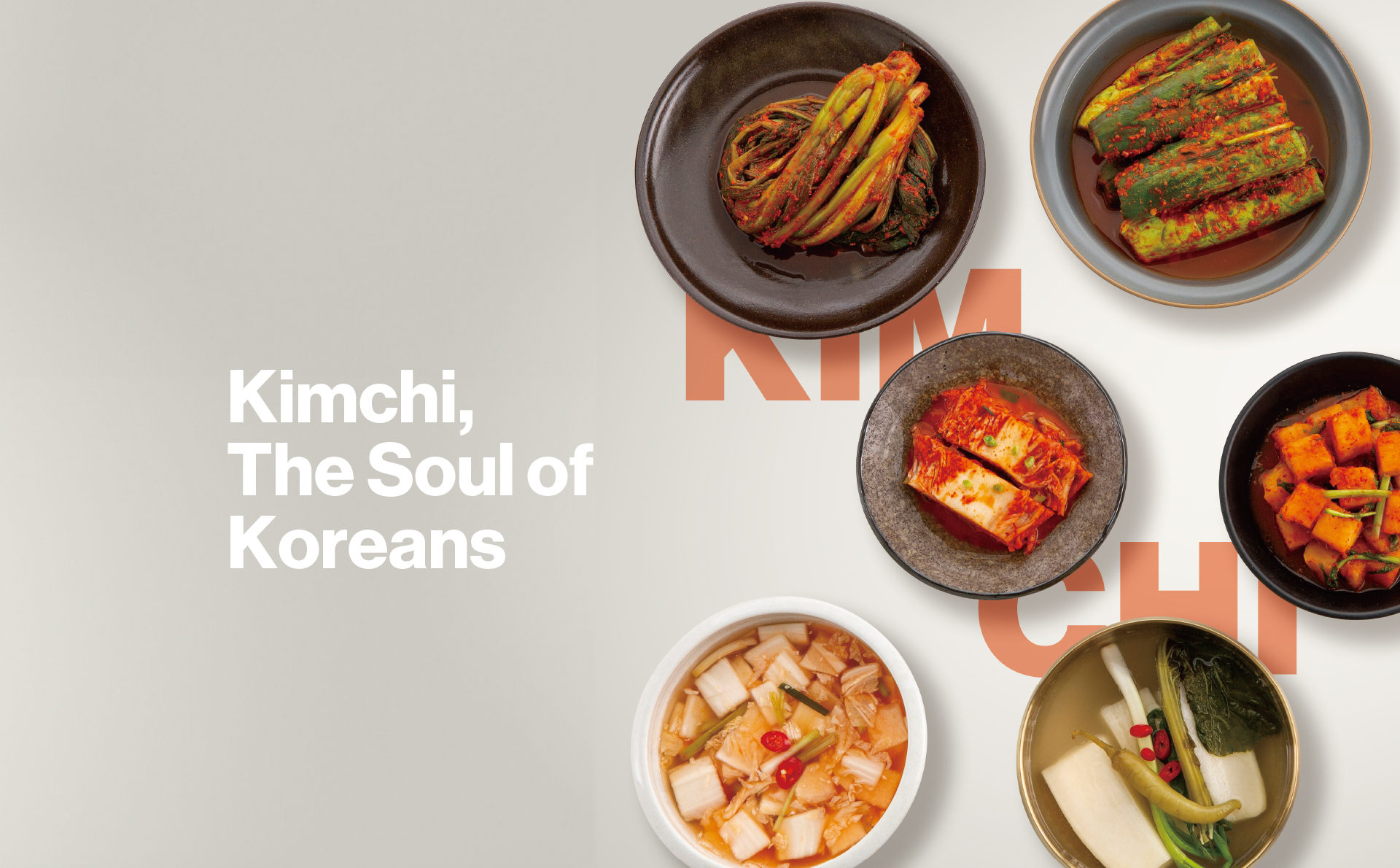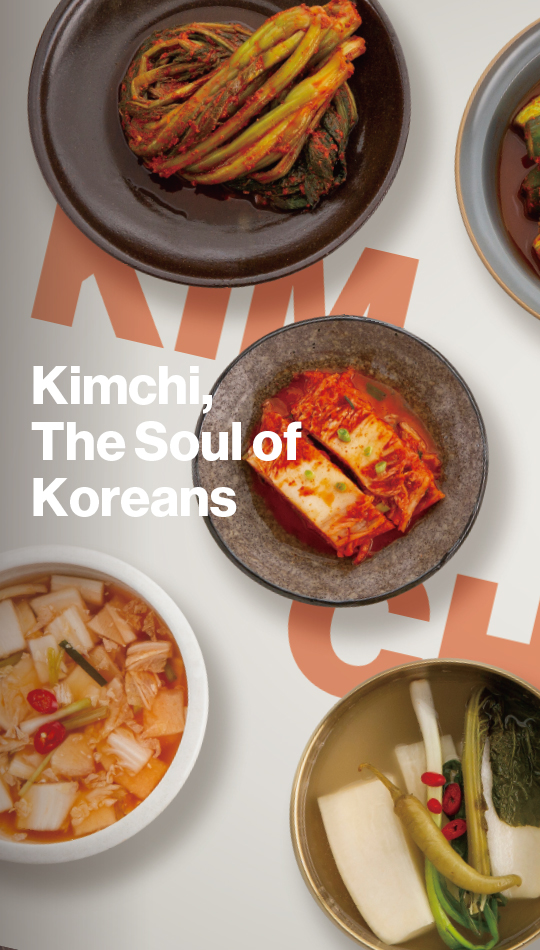There is one thing that comes to mind for many people when talking about Korean food, a dish that is always mentioned without fail: kimchi. Various kinds of Korean food are receiving attention through different forms of media these days. However, kimchi has been at the forefront of introducing Korea long before Korean food was promoted globally. For both Koreans and the world, kimchi is still the most representative food of Korea.


Writer. Sung Ji Yeon
A Fermented Legacy
Kimchi is the most representative food that symbolizes Korea. There is a clear reason why it has reached such a level of representation for both Koreans and foreigners. Kimchi is not just a simple food, but the essence of Korean culture and history.
The deep history of kimchi can be reflected in its various shapes and forms. Let’s think about what kimchi looks like before learning about its history. The first thing that comes to mind with the word “kimchi” is baechu (cabbage) kimchi, a food made from a large cabbage pickled in red seasoning. Baechu kimchi is, therefore, the representative form of the dish that people immediately imagine. It is worth noting that baechu kimchi is actually the most recent form of kimchi.
Other forms of kimchi existed before baechu kimchi. Kimchi has evolved over a very long period of time with changes to the ingredients and forms. The kimchi created during each era is still served the same way today. For example, people added salt and animal-based seasonings such as jeotgal (salted seafood) to make homemade pickled vegetables during the Silla and Goryeo Kingdoms in order to preserve vegetables for a longer time. This is known today as nabak kimchi (water kimchi) or dongchimi (radish water kimchi). Cucumbers and radishes were pickled with salted seafood at the beginning of the Joseon Dynasty. This became the prototype of today’s oisobagi (cucumber kimchi) and kkakdugi (diced radish kimchi). Cabbage, green onions and mustard greens appeared during the late Joseon Dynasty, which gave birth to baechu kimchi, pa kimchi (green onion kimchi) and gat kimchi (leaf mustard kimchi).
Most of the different kinds of kimchi created during the Joseon Dynasty are now referred to as “red kimchi,” but they were not red in the beginning. Red peppers were imported through Portuguese merchants during the 1600s but were only used in small amounts to add flavor to kimchi. The most recent form of kimchi is entirely covered in red seasoning, but it used to be quite different. A great famine struck during the end of the Joseon Dynasty. It became difficult to produce salt, leading to a huge cost increase. Salt had previously been used to preserve kimchi, but the high cost meant people had to use other means to season and preserve the dish. They significantly increased the ratio of salted seafood and red pepper powder, and kimchi became the red-seasoned version people know today. The past lives on through kimchi. It vividly captures the extensive narratives of the country. That’s why kimchi has become a dish representing Korean cuisine.
Kimchi is Everywhere, and Everything is Kimchi
How has kimchi become a staple in the daily lives of Koreans? Korean households set aside a special day to make kimchi in bulk. This event is called kimjang, and all family members come together to make large quantities of kimchi meant to be eaten throughout the year. People come together to participate in the event with other households. Kimjang is held nationwide, and it has its own separate season.
It’s only natural that kimchi continues to appear in new forms. Many people make their kimchi, so it is possible to be reborn with new ingredients and seasoning combinations that deviate from the traditional form. A joke in Korea even says, “Koreans will make kimchi out of anything that can be pickled with red seasoning.” There is even a game based on this joke. The “kimchi game” is when a person says the name of a fruit or vegetable and looks it up online. The person wins the game if no posts or images come up with kimchi made from the fruit or vegetable.
The variety of dishes using kimchi as an ingredient is as diverse as kimchi itself. Almost every imaginable cooking technique has been applied to kimchi, such as steaming, frying and boiling. Kimchi is often served with carbohydrates such as rice, noodles and bread. It can also be applied to food from other countries, such as hamburgers, tacos and pasta.
Interestingly enough, Koreans take kimchi for granted, neglecting to recognize the significance of kimjang, or the fact that almost any ingredient can be made into kimchi, leading to endless possibilities for the dish. Kimchi is present in nearly everything Koreans encounter. Kimchi has been around for every moment, so it shouldn’t be forgotten when people talk about the history of Korea.
Kimchibokkeumbap (Kimchi Fried Rice)
15 mins.
INGREDIENTS
150 g finely chopped kimchi, 2 sausages, 1 green onion, 1.5 cups cooked rice, 1/2 tablespoon ganjang (soy sauce), 1 teaspoon sugar, 1/2 tablespoon red chili powder, 3 tablespoons cooking oil, 1 egg (optional), 1 sheet of gim (laver, optional), 1 teaspoon sesame seeds (optional), 2 tablespoons kimchi juice (optional)
- Finely chop the green onion and sausages.
- Heat a frying pan and add cooking oil, chopped green onion and sausages. Stir-fry until fragrant.
- When the green onion softens, add the chopped kimchi and sugar. Stir-fry together, then add ganjang to one side of the pan and let it simmer briefly before mixing it in with the rest.
- Add the cooked rice and stir-fry it with the kimchi mixture until well combined.
- Serve the fried rice on a plate and top it with a fried egg, gim, sesame seeds or any other preferred toppings.
Kimchi Jeyukbokkeum Taco (Taco with Stir-fried Pork and Kimchi)
15 mins.
INGREDIENTS
2 tortillas, 100 g thinly sliced or minced pork arm picnic, 200 g chopped kimchi, 1/4 onion, 1 tablespoon gochujang (red chili paste), 1/2 tablespoon red chili powder, 1/2 tablespoon sugar, 1/2 tablespoon ganjang (soy sauce), 1 teaspoon cooking wine, 1 teaspoon minced garlic, 1 tub of guacamole, 1 tub of yogurt, 2 tablespoons cooking oil, 1/2 tablespoon lemon juice, 2 tablespoons mayonnaise, 3 cherry tomatoes, a pinch of salt, salad greens as desired
- Mix gochujang, red chili powder, sugar, ganjang, cooking wine and minced garlic to create the seasoning sauce.
- Combine the chopped kimchi, pork and sliced onion with the prepared seasoning sauce.
- Toast the tortillas in a dry pan.
- In the same pan, add oil and stir-fry the seasoned pork mixture until cooked.
- For the sauce, mix the yogurt with lemon juice, mayonnaise and a pinch of salt. Cut the cherry tomatoes into bite-sized pieces.
- On the toasted tortillas, layer salad greens, guacamole, jeyukbokkeum (stir-fried pork) and cherry tomatoes, then drizzle with the yogurt sauce.
